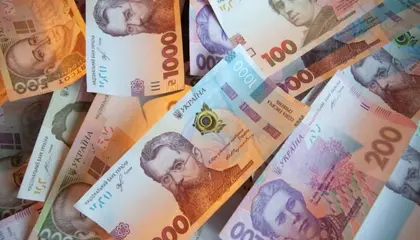Bonds: Local debt refinancing exceeds 100% in 4M23
In 4M23, the Ministry of Finance fully refinanced repayments of domestic debt of UAH85bn and US$1bn.
Last week, the Ministry of Finance attracted almost US$220m and UAH8.3bn (US$226m) to the budget with insignificant changes in interest rates. The MoF reduced interest rates by 5bp for just one USD-denominated issue. See details in the auction review.
Large borrowings in hard currency allowed the MoF to increase the total amount of proceeds in USD in April to US$242m and refinance almost 90% of April's USD-denominated debt redemptions of US$272m. In 4M23, budget proceeds and redemptions in USD nearly equalled and slightly exceeded US$1bn, with the refinancing level at almost 101% YTD, down from 105% in 1Q23.
At the same time, only 78% of UAH redemptions were refinanced in April. UAH25bn (US$684m) was raised and more than UAH32bn (US$875m) was repaid. Therefore, the level of hryvnia debt refinancing decreased to 145% YTD from 185% in 1Q23. On the secondary market, bond trading expectedly increased. UAH bonds traded for UAH15.5bn (US$424m), the largest weekly volume ever. The most traded UAH bonds were securities with a coupon payment this Wednesday and at the end of the month, they accounted for nearly 52% of the total amount of trading.
Nearly all groups of investors increased their portfolios last week. Only portfolios of retail client decreased after redemption of a USD-denominated paper last Thursday. Foreigners purchased UAH3.5bn (US$96m) of local-currency bonds last week.

ICU Weekly Insight: Jan. 24, 2024 – FX-Denominated Bills Support State Budget
JOIN US ON TELEGRAM
Follow our coverage of the war on the @Kyivpost_official.
ICU view: The level of refinancing of domestic debt in all currencies remains above 100%, but risks are high that it may deteriorate in the coming months. The risk is the largest for local FX debt, as there will be large repayments in USD (US$744m) and euros (EUR524m) in May and June, which may be challenging to refinance quickly. Demand for UAH bonds is also decreasing, especially given that banks' investment limits on "reserve" bonds are gradually being filled. However, the significant stock of funds raised in 1Q23 and relatively small repayments (a total of UAH50bn in May and June) should allow the Ministry of Finance to maintain the refinancing level for UAH debt at above 100% in the coming months.
Foreign investors remain the key contributors to activity in the secondary market. A significant increase in their portfolios and large volume of traded bonds with near-dated coupon payments indicate that foreigners are again restructuring their portfolios to repatriate some of their funds during May. However, it is unlikely that they will invest in new bonds soon.
Bonds: Eurobond prices continue to decline
Ukrainian Eurobonds fell in price last week despite slightly improving global sentiment.
Sovereign Eurobond quotes gradually declined, settling mainly in the range of 16-20 cents on the dollar, except for the UKRAIN'24, which was still trading above 22 cents. The VRIs' price hovered around 26 cents per dollar of notional value.
ICU view: Global interest in emerging markets has marginally improved, as indicated by a slight increase in the EMBI index. But it did not have an equivalent positive impact on Ukrainian Eurobonds. They continued to lose value due to purely Ukrainian factors related to the war and a debt restructuring coming next year. The higher price for the UKRAIN'24 compared with the rest of Eurobonds price may indicate investors hope that this paper will receive better restructuring terms next year, similar to the pattern of the 2015 restructuring.
During April, fluctuations in the cash hryvnia exchange rate were within 0.7%, and, overall, during the month, the USD/UAH hryvnia exchange rate did not change.
Since mid-April, the hryvnia exchange rate weakened to UAH37.7‒38.3/US$ as of the end of the previous week, but by last week, it was back to UAH37.4‒38.1/US$, the same level as at the beginning of the month. Thus, fluctuations occurred within a 0.7% range.
On the interbank FX market, demand for hard currency among bank clients (legal entities) slightly eased. They purchased US$1,134m last week, US$88m less than the previous week. At the same time, they sold even more hard currency, US$924m last week (US$53m more than a week ago). Therefore, during the week, the NBU slightly decreased interventions from the previous week to US$445m.
ICU view: The retail segment of the FX market is stabilizing. The segment of non-cash currency is almost balanced, and households have been selling and buying almost the same amount of hard currency for the last three weeks. The cash market fluctuates insignificantly, reacting to temporary changes in demand and supply, with a minor contribution from the pattern in the interbank market. At the same time, the interbank market continues to experience a shortage of hard currency, likely aggravated by impediments to exports of agricultural produce. The NBU continues to satisfy excess demand in the FX interbank market via sale interventions that remain at an acceptable level.
Economics: NBU keeps key rate unchanged
The NBU abstained from cutting the key policy rate or making further changes to the monetary policy design, which was in line with expectations.
While keeping the key rate unchanged, the regulator noticeably improved the macro forecast. In particular, it sees higher real GDP growth in 2023 (2.0% YoY vs 0.3% in the January forecast), significantly lower CPI (14.8% vs 18.7%), and greater FX reserves (US$34.5bn vs US$27bn). Given this optimism, the NBU has also improved the outlook on the key rate, now expecting the first cut in 4Q23 rather than 2Q24.
ICU view: Should the current trend of moderating CPI prevail, the regulator is likely to cut the key policy rate even prior to 4Q2023 and/or further soften monetary policy in another way, as it did in March by changing the monetary policy design.
Economics: Current account balance turns positive in March
The current account balance turned positive in March on a significant reduction of the trade deficit.
In March, monthly deficits of trade-in-goods and trade-in-services narrowed substantially vs the first two months of the year. The total deficit of foreign trade in goods and services stood at $2.6bn in March, down from $3.2bn in February and $3.6bn in January. Also, the primary income balance improved on lower outflows of investment income and robustly high migrant income abroad. Official transfers to the government were down somewhat MoM, and they remain driven by budgetary grants provided by the US.
Meanwhile, the financial account saw the largest monthly net inflows of capital since russia’s full-scale invasion of Ukraine, at nearly $3.0bn as the government received loans from the EU and Canada for a total of $3.3bn. The largest channel for capital outflows is the increase of FX cash out of banks. This reflects FX cash withdrawn by households abroad from their hryvnia accounts at Ukrainian banks and also withdrawal of FX deposits. There is also a silver lining to the BoP data. Foreign trade credits were down significantly in March for the third month in a row. This indicates that private capital is partly being transferred back to Ukraine thanks to stability in the FX market.
ICU view: Balance-of-payments indicators have been quite predictable so far and do not signal any new looming risks on horizon for the economy. The balance of trade and net private capital flows remain hugely negative, but they are easily offset with international financial assistance. We expect the current account deficit will be at a reasonable 2-3% of GDP for full 2023, and net inflows via the financial account will substantially exceed this C/A shortfall. Thanks to this, the NBU will be fully equipped to alleviate the deficit in the FX interbank market via FX sale interventions, thus keeping the exchange rate stable.
RESEARCH TEAM: Vitaliy Vavryshchuk, Alexander Martynenko, Taras Kotovych, Mykhaylo Demkiv
You can also highlight the text and press Ctrl + Enter






